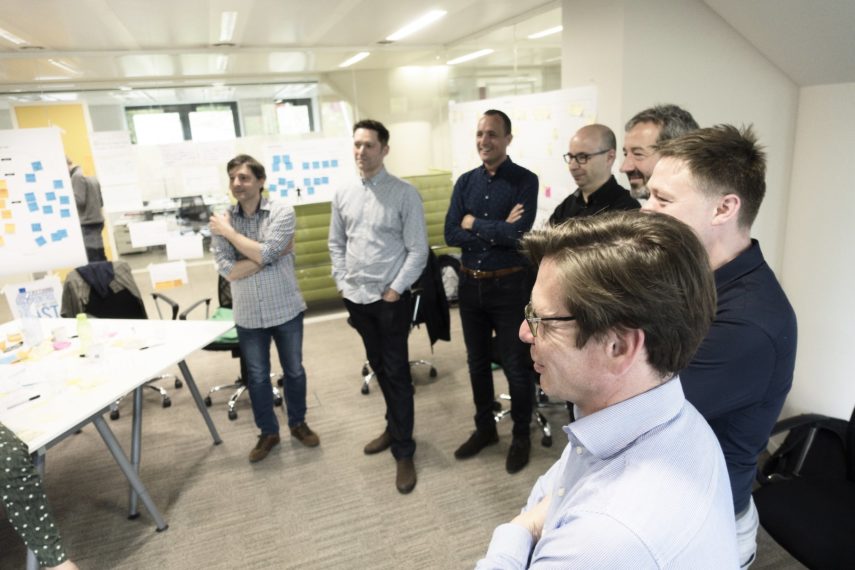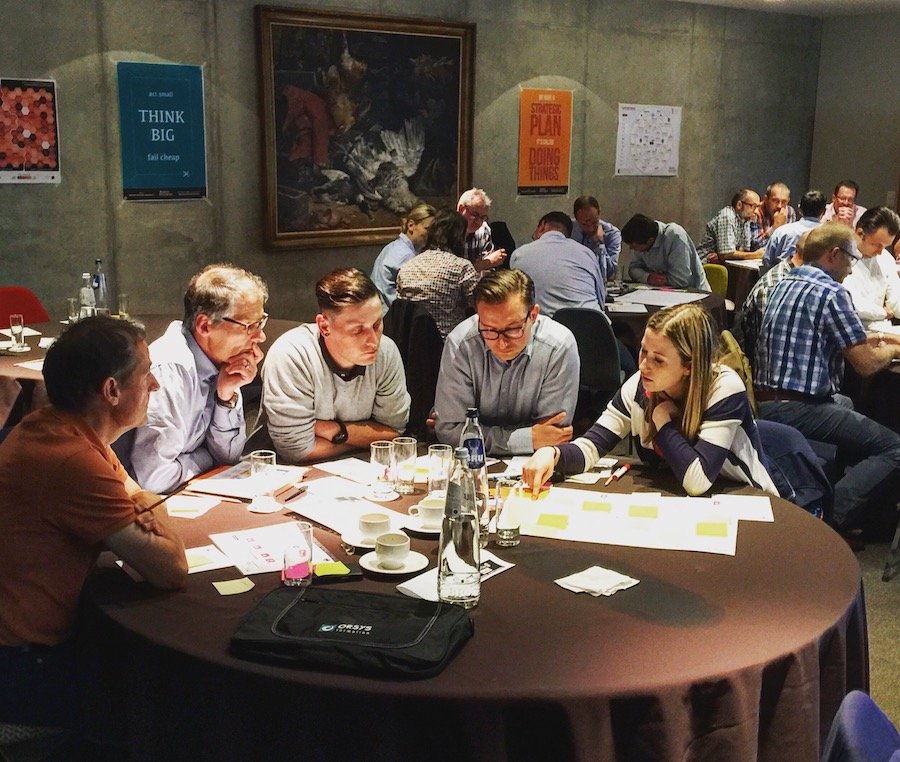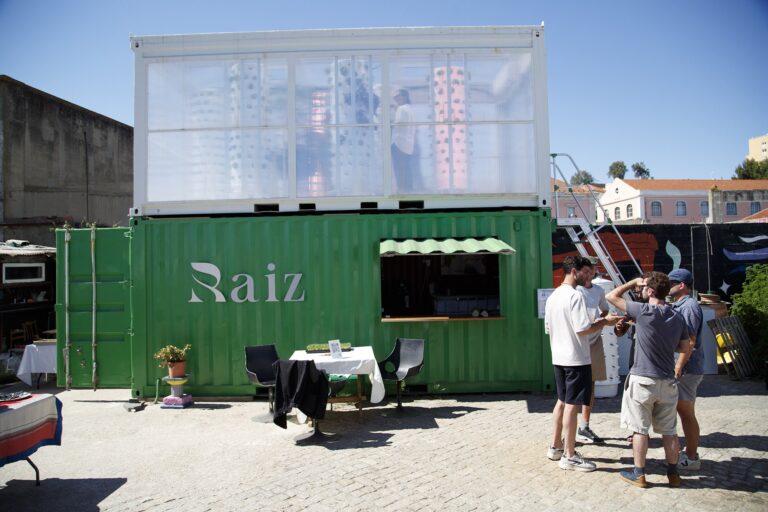B2B co-creation is a powerful way to co-create new business value with your most important customers by closely iterating back and forth throughout the innovation process. Our approach is to combine methods from Design Thinking, Lean Startup and Business Model Innovation with specific customer facing formats to inspire participants whilst engaging with the key values of user, business and technical partner-buyer perspectives.
New revenue ventures will compliment strategic perspectives. HR will gain holistic cross-disciplinary thinkers and do-ers. Sales managers will gain higher and faster hit rates, all-the-while, fostering closer and stronger customer network relationships with the partner company.
The goal of this article article is to give you key insights into how we run B2B co-creation programs, whilst sharing some of our best practices and learnings along the way.
- What is B2B co-creation?
An innovation program where you involve a real B2B partner customer. You co-create in a strategic corporate partnership whilst building a win-win situation for greater B2B business impact.
Myth-buster: Co-creation is not just for B2C contexts. B2B co-creation, otherwise known as corporate partnerships, has a lot of opportunity for big impact when it comes to innovative business offerings between manufacturers and their most trusted customers. We’ve seen firsthand how successful it can be and wonder why more organizations aren’t doing co-creation programs. Where innovation is concerned, the interesting territory to cover between businesses often isn’t being covered. It’s a shame, really, as doing so would create new business impact and solve many unmet needs and problems.
The domino effect of businesses working together in the innovation sphere increases speed to market, solves customers’ problems faster and reduces all-round risk.
Over the course of the next two weeks, we’re going to share our most insightful insider’s knowledge of running corporate partnership programs to give you a short “how-to” guide and help you on your way to creating more value for your customers. Here’s the first part…
Part I: Set-up phase of the B2B collaboration

#1 Organizational strategy
- Have a clear innovation strategy defined up front so that output innovations are strategically implementable and/or disruptive.
- In most cases, when running an innovation program or workshop, aim for radical and disruptive concepts and business models. They can always be made more safe afterward, for example, from radical to more adjacent innovation (optimizing existing products for existing markets) or incremental innovation (leveraging existing product to reach new markets).
- There are two opportunities to disrupt during the program: during the development of the concept, and when deciding on a business model. It is crucial to aim disruptive outcomes during both.
- In our experience, radical concepts and business models excite and motivate “dragons” (aka client-side problem owner) and customers the most because they open up new areas for business that might otherwise not be explored. Push the teams in this direction.
- Clearly brief customer round table participants and final dragons about the program design. Explain why each step of the co-creation process — 1. desirability 2. viability and 3. feasibility — is important to follow in that order. Many people skip straight to “technical feasibility” as they consider it the most important and realistic factor from prior experiences. Remember: alarm clocks kill dreams, and feasibility arguments kill ideas in incubation.

#2 Program design
- Ensure you host the modules at an inspiring startup co-creation space to reinforce the open mindset and way of working. Teams will derive and reinforce disruptive thinking from the meaning of their working environment.
- Run a start-up safari at the beginning of a co-creation innovation accelerator to hear startup insights and different ways of working first hand. This will set the scene nicely for the following duration of the program.
- Manage expectations all the time for all stakeholders. The main theme you want to get across is: This process is not the usual way of working. This is supposed to be about doing something else and you’re going to feel outside your comfort zone and this is ok. It’s about rewiring the ideation brain.
- Give teams the mandate to operate like a startup outside normal routines and processes to reinforce the idea that what is happening is an experiment and a safe place to try radical ideas and business models.
- When running multiple project teams, ensure each team has a different client problem area to conduct initial problem exploration interviews. This avoids overlap and ensures greater insights from which to ideate.
- B2B co-creation is not the same as B2B design thinking. B2B design thinking uses customer insights at the beginning and end stages. B2B co-creation is about involving the customer throughout the innovation cycle – before, during and after. We typically include the customer at six different co-creation moments throughout a program.
- Give teams their own budgets and/or resources to spend on experimentation and validation phases so that they can get things done faster whilst being empowered to do so.
- You should run ’round table’ consultation sessions (comprising a broad range of senior profiles) from the customer and from your organization during 1) ideation/concepting and 2) initial business model iterations.
- It is better to host accelerator modules with global teams in back-to-back 3-5 day sessions rather than spread out over fragmented days as this keeps focus and momentum.
- At Valmet, where we regularly run B2B co-creation twice yearly, usually sponsors wish to have business impact as the main outcome. Determine how much of a balance you want between learnings and mindsets vs. concrete project business outcomes. Typically, it is around 70% // 30%.
- Make teams accountable to an advisory council during key pitching moments for longer term projects. The innovation council should allocate additional people, time, and resources and remove road blocks if needed. Consider it like the Council of Elrond, minus the elves.
- Make sure you have senior strategic or C-level dragons on both customer and client investment panels to add positive pressure to perform within project teams at critical deliverable moments.

#3 Program set-up: scoping inputs
- Look at charging a nominal fee to partner customers to participate in your innovation accelerator. This changes the participation/motivation dynamic from something that you want from them, to being a privilege to participate in.
- Scoping client problem topics is a challenging process to nail. Make sure it is broad enough to allow teams to explore a range of key needs and problems through open-ended questioning. These problem areas should then be discussed in relation to the three horizons of innovation framework to ensure there is a strategic fit on potential outcomes possible.
- Train project teams up-front in how to effectively conduct problem exploration empathy interviews correctly by asking open-ended questions and diving into insights using techniques like the 5 why’s.
- One of the most challenging parts of B2B co-creation is translating problem interview insights into correctly scoped HMW (How Might We) statements to get ready for ideation rounds. A good amount of time is needed to get the scoping right. For example, if the HMW is too specific, then it might mess up the ideation process as there isn’t the space to design anything new or radical. This is an iterative process that needs expert facilitation to get right.
- Clearly define intellectual property ownership rights up front with the partner customer. Better to get the boring stuff out of the way first so the real sticky stuff can begin: Post-It note ideation.
- Involve the B2B partner right after initial concepts have been developed before moving into prototyping anything with designers. Make sure it solves their original problems. Do a reality check and save yourself a mental breakdown: validate the key problem solving solution features and critical assumptions first, before building anything.
- Run a pilot test program with a friendly customer first to learn and tweak your co-creation process. No two companies are the same, so being adaptable in program design is essential. We’ve seen situations where an unfriendly customer at a company shut down the whole process, yet another friendly customer at the same company gave it the green light.
- After starting your B2B co-creation with a friendly customer, move on to running further collaborations with a list of other top clients.

#4 Customer touch points: involvement
- Try to involve your B2B client in the modules/bootcamps to actually co-create with them on site. This is a big request, but is the ideal scenario in that you are doing true B2B co-creation together.
- Make sure your first generation minimum viable products (MVP) are tested with the same problem owner from your problem exploration phase to ensure you get validation from your original problem and budget owner.
- When showing MVPs to B2B customers, make sure the project teams know they are not trying to sell their solutions, but merely seeking to learn if it solves their problems through critical assumption (in)validation testing. As Steve Blank points out, you are expected to fail early, right away, and learn. Rarely, if ever, do initial concepts get it 100% right the first time, and that’s really ok. Learning fast is exactly what the co-creation innovation process is all about.
Part II: Implementation and outcome stage of the B2B collaboration
In the previous part, we covered 4 areas of what an optimized corporate partnership looks like in the set-up phase of the B2B collaboration. Now, we’re going to dive deeper into the business-to-business co-creation process to lead you through to the implementation and outcome stages.
Successful corporate partnerships in the innovation sphere increase speed to market, solve customer problems faster, and reduce all-round risk because of the process they follow. Get on the bandwagon and keep on reading.
Take a sneak peak at a B2B co-creation partnership that we’ve been running in the paper, pulp and energy sector with Finnish company, Valmet OY.

#5 Team formation
- Split team members into groups according to multi-disciplinary profiles across age, gender and experience. Make sure the groups are made up of 3-5 people. Any more than this and the teams will become unmanageable as they will break out into subgroups and not focus on task as a team.
- Allocate a team lead and project members for a fixed amount of time (say, 1 day per week) to prevent other work priorities from taking over and watering down team efforts. Teams should fix and block time in their agendas, for example: Tuesday and Thursday afternoons. This will make it easier to plan validation interviews, collaborate and allow for easier remote working.
- Make sure you assign each project team a client contact who is also the problem and budget owner.
- Involve two or three customer profiles from different roles during ideation and business modelling sessions. This works especially well if you include your customer(s) in speed-dating or 15-minute consult sessions with each project team to get vital (early) customer inputs to make sure you’re on the right path in terms of solving needs.
- Involve designers, user experience/user interaction prototypers to make mockups, minimum viable products (MVPs) and prototypes physically tangible. One per project team is necessary to speed up and level up visual language to test with customers for (in)validation experiments.
- If some teams complain that the speed of a program is too fast, then you’re probably going about the right pace. It’s a sign that they’re outside of their comfort zone and working in a way that is unlike what they’re (comfortably) used to!

#6 Anticipated problems
- There are six main barriers: cost, time, resources, capacity, creativity, and fear of change. They are all equally as damaging to the innovation process. Guess which one is the biggest you’ll face with project teams? Time. Freeing up agendas is one of the most common problems we encounter. Determine how will you solve this.
- The first day, teams will be in what we call the initial “zone of skepticism“. They will be in this phase until they see the value of trusting in the facilitation, themselves and the process itself. Time will change this skepticism, as will buy-in. Keep the process flowing and they’ll get on board in no time and fully commit to the way of working.
- Don’t allow project teams to bring solutions to the program! Place them gently in front of a special wall for post-it ‘parking spaces’. We understand the desire to be solution-oriented, but there is a time and a place for that, and it’s later down the innovation pipeline.
- Once teams have conducted problem interviews, they will need help to cluster, analyze, and prioritize insights before turning them into How Might We (HMW) statements. This is a tricky phase to get right as it is iterative until the scoping is just right. Not too broad and not too narrow. Spend a good amount of time here. Rule of thumb: 1 hour max.
- When generating a massive number of ideas, teams can become stressed by the fact they are parking other “good” ideas. Capture these ideas at the end of the concept ideation phase on additional concept cards to share with the sponsors.
- At some point, clients and customers will default to their knee-jerk technical feasibility reflex. The question “is it possible?” is an instinctive place to start when it comes to innovation, but it should be put off until you have validated learning evidence for both customer desirability and business model viability. Challenge this feasibility reflex, and remind them why it is third priority. Eventually this principle will stick and the reflex will fade away. (See Part 1 – Organizational Strategy for more information about the three steps of the design process).

#7 Career paths
This one is a short one, because there isn’t much to say about it. Nonetheless, it requires its own category to show how important it is.
- Create reward, compensation, and career path trajectories as a result of participation in co-creation programs. Direct incentive is needed, otherwise it’s simply “nice to have” but there is no motivation to continue working in this way outside the program.
- Think about allowing team members to shift departmental roles, say from engineering to sales or from marketing to R&D. Perhaps you will allow a project team to operate their own startup with coaching support for a limited time (and budget). Or even assemble an elite team to tackle a radical innovation project. If you don’t think about these things early on, your best talent might seek opportunities elsewhere.
- The expression “it’s not what you know, it’s who you know” applies equally to the innovation sphere as it does to other aspects of life. All the business know-how in the world won’t help you if you don’t have ingenious intrapreneurs working to make things happen.

#8 Program outputs
- Make sure teams have access to: self help, internal support and external coaching where and when needed. Everyone needs a little extra company TLC when pursuing innovation, particularly for the first time.
- Clearly define what happens to output innovations. What is the investment plan? How can you free up agendas? How will you continue to collaborate with the customer? How will you continue to work in this iterative way with your internal teams once the program has come to an end? It’s important to have these hashed out before starting your co-creation program so that teams don’t lose momentum and rah-rah enthusiasm.
- Run an internal program community or alumni group on something like Yammer or a team site where teams can post questions, share new learnings and experiences to spread the virus.
- Make sure you run follow-up sessions and conference calls with participants to capture learnings and learn about the impact the program has had on their day-to-day work and mindsets. Assessing the impact is key here, as well as quantifying it with impact KPI’s.
- Develop a playbook and toolbox for teams to use after the program. With these tools at their disposal, they can apply all or parts of the process in their daily working lives. Innovation programs are not supposed to be nice “one-off” exercises or innovation theatre. Rather, they’re about creating paradigm shifts in the hearts, minds, culture and workplace processes around innovation.
- After final “dragons’ den” pitches with the customer and internal executive team, nominally reward winning teams with small gifts such as chocolates and/or certificates to create some pomp and ceremony. Pats on the head work too, but chocolates are better.
- Keep team and project momentum going by pitching new concepts again internally to business unit heads with a more of a focus on what that means business wise for your organisation without the customer present.
What next?
Now you have a thorough breakdown of the key essentials on how to run a success corporate partnership for B2B co-creation. We hope you’re in a better place to figure out how they might work for your business impact.
If you would like advice that is tailored to your company and industry, let us know and we will book a quick call. If you simply have burning questions about what you’ve just read, feel free to reach out to us. We love feedback and learning about our work too. It’s part of our DNA and keeps us humble.

Co-create new business with your most valued B2B customers.
Solve customer needs and problems faster!


